 The e-zine about Elftowners, by Elftowners, for Elftowners.
The e-zine about Elftowners, by Elftowners, for Elftowners.

The Rorschach Inkblot Test
By [Rice]

The Rorschach test, also know as the Rorschach inkblot test, is a test often used by psychologists and psychiatrists. It involves a series of ten cards, all with different inkblots on them. The subject, for example the person seeking help from the psychiatrist, is told to look at the inkblots and tell the doctor the first thing that comes into their mind. How they perceive the inkblot is then analysed using psychological interpretation and also scientifically derived algorithms. The test is named after its creator, Herman Rorschach, and is most commonly used to examine a person's personality type or emotional state of mind.
Many people are under the mislead impression that the Rorschach test's outcome is merely created by what the subjects see in the card. However, this actually makes up a very small percentage, the Rorschach test is actually a very clever devise with which the psychiatrist observes your behaviour with each card. For instance the first card, that's inkblot is rather trivial, is a way for the psychiatrist to discover how the subject tackles new situations and deals with stressful tasks.
In fact the cards are very cleverly made so that there are only a few answers it could possibly be, thus it is the person reaction and behaviour that tells us about them. The card's also use colour to reflect emotion, for instance the second card has the colour red which instinctively we see as 'blood' due to the splat formation of the colour. This then usually demands a rather dark answer, like two people fighting, this then provokes feelings within the person of anger or physical harm and the psychiatrist can judge how the person reacts to that kind of situation.
However, while this test seems quite clever there are many downfalls since as with most things there are too many variables to consider. Cultural differences are one since many case studies have shown that people from different parts of the world react differently to the emotions portrayed in the cards, for instance American's react more solidly to the positive cards where as people from Europe react more to the negative. Reliability is also an issue since it has been proven that the results are influenced substantially by the testing procedure, where it takes place, what doctor initiates the test, right down to how the doctor introduces themselves. If the Doctor is friendly and outgoing when greeting the subject then of course the person will feel more at ease and be more likely to give positive response, vice versa with a rude greeting. The test is very controversial and shunned due to its lack of quantitative data since most people deem that the results ere sheer conjecture as opposed to scientific fact.
On the other hand, considering how much the test has been debunked by scientists it is still used quite excursively by psychologists. A recent survey showed that 20% of psychologists in America still use the Rorschach test, 30% of forensic psychologists, and 23% use to to examine children. And also 80% of all psychology students are taught about the Rorschach test proving that whilst it may be qualitative and up tot interpretation
, it is still considered a fairly good method to analyse someone and get a deeper understanding of them.
The cards themselves:
1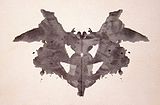 2
2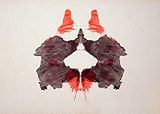 3
3 4
4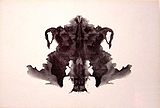 5
5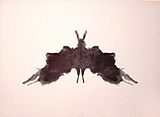 6
6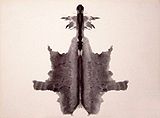 7
7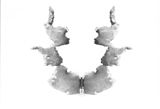 8
8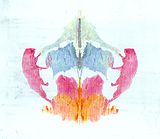 9
9 10
10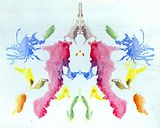
Things you should note:
1. The inkblot itself is not important, the subjects reaction to new situations is what's being observed. (Most common response, bat, butterfly, moth, any winged insect or small animal)
2. The use of the red splats is an obvious symbols of blood, though one the subject might not realise. The blot itself is done to look like two figures, thus together signifying a fight or conflict. (Most common response, two humans)
3. Also used to signify two people though this time the red markings are less angular and spiky and more smooth edged. This creates a less threatening picture, this one is used to judge how the subject relates to other people. (Most common response, two humans)
4. A very large dull inkblot that is chunky and more than often used to create fear of anxiety in the person. Can sometimes cause a depressed feel due to the murky colour. (Most common response, a body, animal hide, anything dead)
5. It is a very delicate pattern and much smaller than the previous card, it is sued to cause a change of pace within the subject and take them from the menacing 4th card to a much gentler card. (Most common response, butterfly, moth)
6. The general look of the ink in this card is the main focus as apposed to the shape itself. Note the darker inside and feathered edges, due to this it is considered extremely sexually. (Most common response, skin)
7. This card is also called 'the mother card', its dominate characteristic is femininity and can be used to judge the person reaction and possibly link to a major feminine person in their life. It can also be seen as a sexual card as many people perceive to open mark in the middle as a 'vagina'. (Most common responses, face)
8. Card 8 is the main 'change of pace card', which is evident from the switch from black to bright colours. It can cause relief in the person but also confusion due to the vast amount of colours and possible difficulty in locating a response. (Most common response, some form of animal, usually a type of shellfish)
9. Many subjects have difficulty in processing this card because of its large size, amount of colours and general vagueness about the detail. The response to this card varies vastly and is more than often used to observe how the person copes with an inability to process data, or stressful tasks. (Most common response, human face)
10. Being the last card it makes the subjects response and behaviour very important. While it is just as chaotic as the 9th card the subject will often relax in the notion that the test is almost over and can sometimes zone out and reflect on their emotions during the test. This means that the response will often be directly linked to some inner feelings they picked up on during the test itself. (Most common response, crab, spider, lobster, usually some animal with many legs)
Sources of information:
http://en.wikipedia.org/wiki/Rorschach_test
Psychology for AS-Level http://ecx.images-amazon.com/images/I/51713V7V1GL._SL500_AA300_.jpg
General knowledge
Personal opinion.
Pictures: Rorschach, Hermann (1927). Rorschach Test – Psychodiagnostic Plates. Hogrefe. ISBN 3-456-82605-2.

Go or Return to:
...The Town Herald - Issue 22 entrance page
...TH Issue 22 Index page
...The Town Herald official wiki page
 Stumble!
Stumble!


 2
2 3
3 4
4 5
5 6
6 7
7 8
8 9
9 10
10
